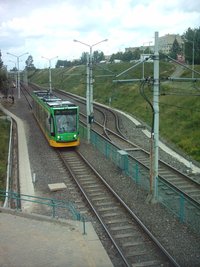Poznanski Szybki Tramwaj
|
|

Poznański Szybki Tramwaj (PST, "Pestka") (Poznań Fast Tram) - a 6.1 km long stretch of collisionless, set in a ditch or an overpass, tram line fit with sidings, switches allowing to drive on adjacent tracks, and stops resembling railroad stations, each in a different colour. All of this enables for the speed exceeding 70 km/h. This unique tram line was created as an alternative for more expensive subway. The existing stretch, inaugurated in 1997, links the densely populated northern districts of Winogrady and Piątkowo with the city center (downtown). It is served by lines 12, 14, 15 and 16 (except summer), as well as night line N21.
| Contents |
Basic information
- Length: 6.1 km
- Number of stops: 6
- Maximum speed: 70 km/h (40 km/h on switches)
- Capacity: 5000 persons per hour
- Trams run every 2,5 minutes in peak time, otherwise every 5 minutes
Background
Estakada_ponad_Bogdanka_Poznan.jpg
Poznań is a city of 580 000 inhabitants, with ca. 200 000 more living in the suburbs. City's commerce is located in the centre, while most light industry is located uptown or in the suburbs around the city. Hence most trips by public transport are to and from the centre.
[cdn]
History
Poznań's public transport company started its business activity in 1880, with a few horse-pulled trams. At that time, the town was inhabitated by ca 70 000 people, and was not growing due to building restrictions imposed by military administation.
Soon after the company was established, the construction limitations were lifted, and the town grew very fast to about 200 000 inhabitants in 1920's. By that time there were some early ideas of creating a non-collision line that would link the centre with one of the northern district. Neither technology nor the budget allowed for a construction of such a tram line, and metro of the Berlin style would be generally too big and unnecessary. Thus the plans were put on shelf until much later.
In 1960's and 70's, Poland's communist government built communist style blocks of flats in the north and east of the city. Such concentration of flats create high population density and thus high demand for transportation needs. Needless to say, getting to the city centre by bus was hell: 7 kilometres took between 30 and 45 minutes by bus. However, a corridor was left for the construction of a tram line, but the inability of communist government to manage funds and work efficiently meant that between 1975, when the work commenced, and 1989, only a fraction of the work was done. Originally, the line was meant to be separate from the tram network, with a terminus in the city centre.
After the government (and system) change in 1989, the construction gained pace. In 1996 the line was finished and connected to the existing tram network.
Present day
The line officially opened on March 1, 1997. Time taken to get to the centre decreased from ca 40 minutes to about 10-15 minutes. This, combined with limited and paid parking space in the centre contributed to the huge success of the line. In peak hours it was, and often still is, hard to get on the bord of the tram. In 1999, another tram line (no. 16) was added, but the capacity of the tracks is reaching security limits. With the new line 16, trams run every 2.5 minutes in peak time, and the line has not been fitted with so called "blocking devices", which stop vehicles from entering the same section of the track. So for security reasons there cannot be more trams per hour than there are now.
Another issue are the communites which the tram serves. Those are mostly block-of-flats districts, which are not necessarily inhabited by the most succesfull members of society, so the tram suffered from acts of vandalisms (as seen in the picture below), and lack of security. Those acts, however, diminshed when surveillance cameras were installed. The tram has had also a very positive impact on those communities, making it more attractive for investors and stopping the decrease of population.
PST5.jpg
Some institutions and companies server by the tram, listed by station: (those marked by a plus (+) have moved after the opening of the line):
- Słowiańska (green) - academic dormitories, Court of Laws (+)
- Serbska (yellow) - 3 supermarkets (+), a large office buiding (+)
- Lechicka (blue) - supermarket (+) Poznań Plaza
- Kurpińskiego (orange) - a bank (+), a small supermarket, a clinic
- Szymanowskiego (red) - a supermarket (+), and a large new development of modern appartament blocks
- Osiedle Jana III Sobieskiego (terminus) - University campus
Future development
Similar fast tram network exist in other parts of the world, namely in Vienna, Amsterdam and Brussels, and several other cities, like Karlsruhe have gone a different way in extending their tram networks. However, those cities are much larger and have gone further into the development of trams into metro-style, heavier vehicles. It was therefore important for the Poznan administration to find out how successful the program would be.
Since the program has proven successful, another extension has been started in early 2005. This time it connects the city centre with eastern block-of-flats districts. It is not truly a fast tram of the same scale, but the success of the first program has prompted the authority to rebuild an existing line into a faster one.
